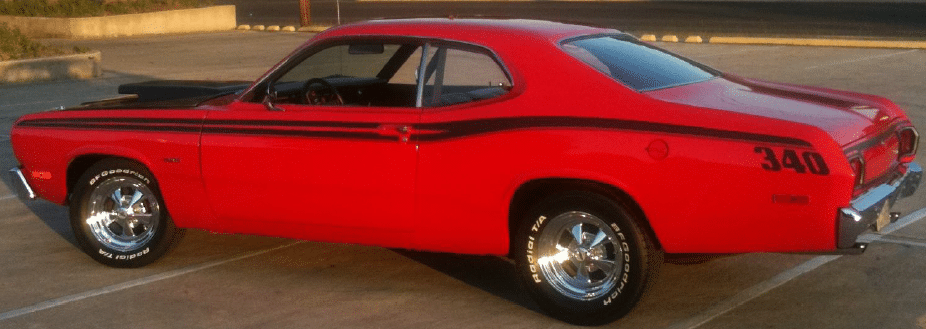To tell my Duster’s story I first need to begin with how I came to be a MOPAR fan. In 1962 I was a high school junior and like most guys loved drag racing. On one Sunday afternoon at the drag strip, we were ready to settle in and watch the super stockers go at it. As usual we were expecting to see 409 Chevys, 406 Fords and 421 Pontiacs go at it heads up. Then I happened to look over my shoulder towards the main gate and I saw this ugly white car sitting on top of its trailer being towed by a pickup. When it came into the pits it had SS/AA on the windows. By now we could see it was a Dodge and on the side of the pickup it said “Sam Dells Dodge.” Sam Dells was the Dodge dealer in nearby Syracuse, NY. A Dodge with a sponsor? Well we had to take a closer look. The car was a plain old basic 2-door post hardtop with red seats, no radio, no nothing. The first thing we noticed was the absence of a floor shifter and no shifter on the column either. Then I spotted the buttons on the dash left of the steering wheel that were marked L 2 D N R. What the heck? An automatic going up against 4 speeds!? He hasn’t got a chance. The hood of the car was raised about 2 or 3” in the back of all places. I later learned this was for venting heat as well as pulling in fresh air.
We couldn’t believe our ears when that Dodge fired up much less believe our eyes when it launched. It was turning faster ETs and MPH than the 409s, 406s and 421s. What was this thing? When the Dodge went back into the pits the driver popped the hood. Everybody scrambled to get a look at the engine. What stood out immediately was the unusually large flat top intake manifold and two four bbl carbs offset from each other versus the standard inline 4 bbls the GM and Ford cars used. We also noticed it wasn’t using aftermarket tubular racing headers. It had stock exhaust manifolds that curved up high along side the heads. We figured the cutouts we saw poking out the side of the car were welded in. We asked the driver why cutouts instead of headers? He told us to look under the car and what we saw was open exhaust pipes built into the exhaust system by the factory. We thought that was very cool.
At the end of the day the Dodge took the SS class. Since it was the only automatic super stocker they put it in the SS/A class to run heads up with the 4 speed cars. It was unbelievable to us “kids” how an automatic could hold up much less outrun the stick cars. As we later learned, the car was a 413/420 horse power with the Torqueflite trans and purpose built by Chrysler’s Plymouth and Dodge Divisions for racing.
Pretty much from that day on I became a MOPAR fan. After High School, I enlisted in the Air Force (1963). On E2 pay all I could afford to drive was a beat up 56 Ford sedan. I went to Vietnam in 1965 and vowed I would save enough money to buy me a new hot rod Plymouth or Dodge when I got back (we didn’t refer to them as muscle cars at that time).
A year later I returned from Vietnam and went shopping for my MOPAR. It didn’t take long for me to realize I didn’t have enough money. I had zero patience and didn’t want to wait any longer, so I opted for a new 66 Chevelle Malibu. The car had a 327 small block, 4 speed rock crusher and a 4:11 posi rear end. It was a fun car and I kept it for two years.
In the fall of 1968 I had some money saved and if I sold the Chevy I should have enough to buy a new 69 Roadrunner. My roommate bought the Chevy. Then I went to the local Chrysler, Plymouth, Dodge dealer looking for a new Roadrunner. This was September 68 and the dealer was just getting in the new 69 models. He had received two Roadrunners but both had money on them. Then he showed me the two 69 GTXs that he recently got in. They were beauties but above my pay grade. I was about to leave and then he told me he still had a 68 GTX they used as a demo and it was for sale. It had about 500 miles on it as I recall. After a test drive I said I would take it if he would give me a price I could afford. After some haggling we finally agreed on a price.
That car served me very well on the street and the local drag strips. In 1971 I had an opportunity to buy a 1970 Dodge Charger R/T 440 Six Pak. It was used as a pace car at the local 3/8 mile roundy-round track. It was on loan to the speedway from the dealer I bought the GTX from. I just had to have that car. So I sold the GTX, added $800.00 to what I got for the GTX and bought the Charger. That thing was wicked fast.

